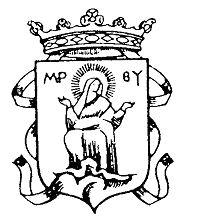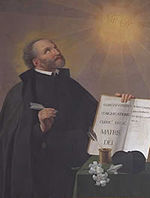Clerics Regular of the Mother of God
Ordo Clericorum Regularium Matris Dei | |
 Coat of arms | |
 John Leonardi, founder of the OMD | |
| Abbreviation | OMD |
|---|---|
| Formation | September 1, 1574 |
| Founder | Saint John Leonardi, OMD |
| Founded at | Lucca, Republic of Lucca |
| Type | Religious order of clerics regular of pontifical right (for men) |
| Headquarters | Rome, Italy |
Members | 110 members (72 priests) as of (2018)[1] |
Rector General | Vincenzo Molinaro, OMD |
Parent organization | Catholic Church |
| Website | ordinedellamadredidio |
| [1] | |
The Clerics Regular of the Mother of God (
History
Leonardi was born in 1541, the son of middle-class parents, at Diecimo (now within the comune of Borgo a Mozzano) in the Republic of Lucca. He was ordained on December 22, 1572.[2]
Leonardi's Order may be said to have begun in 1574. Two or three young laymen, had gathered round him to submit themselves to his spiritual guidance and help him in the work of reform which he had begun even as a layman. Leonardi rented the Church of Santa Maria della Rosa in Lucca and, in a quarter close by, something like community life was started. It was here, when it became evident that his lay helpers were preparing for the priesthood and that something like a religious order was in process of formation, that a storm of persecution broke out against the devoted founder. The leaders of the Republic or Lucca seem to have had a real fear that a native religious order, if spread over Italy, would cause the affairs of the little state to become too well known to its neighbours. The persecution, however, was so effective and lasting, that Leonardi practically spent the rest of his life in banished from Lucca, only being now and again admitted by special decree of the Senate, unwillingly extracted under papal pressure. In 1580 Giovanni acquired secretly the ancient Church of Santa Maria Cortelandini (popularly known as Santa Maria Nera) which the Order holds to this day.[3]
In 1583, the congregation was canonically erected at the instigation of
In 1601, he obtained the Church of
The present church of the order in Rome, obtained in 1662, is
In 1614, Pope Paul V confided to the congregation the care of the so-called Pious Schools. It is in his Brief "Inter Pastoralis" that the congregation is first called "of the Mother of God", having until then been known by its original name of "Clerics Secular of the Blessed Virgin". The care of these schools being considered outside the scope of the congregation, it was relieved of their charge by the same pontiff in 1617.
It was not until 3 November 1621 that
Leonardi received many offers of churches during his life, but, hoping to reconcile with the governing body of the Republic, thought it better to refuse them. In all its history the Order has never had more than 15 churches. In 2008 it had eight, all of them in Italy. They include that of Santa Maria Corteorlandi in Lucca and Santa Maria in Campitelli in Rome.
In the
Two of the original companions of the founder, Cesare Franciotti
The coat of arms of the Order are azure, representing Our Lady Assumed into Heaven; and its badge and seal the monogram of the Mother of God in Greek characters.
References
- ^ a b c "Clerks Regular of the Mother of God of Lucca (O.M.D.)". GCatholic. Retrieved 2021-11-22.
- ISBN 0-385-13594-7.
- ^ a b c Carmichael, Montgomery. "Clerks Regular of the Mother of God of Lucca." The Catholic Encyclopedia Vol. 4. New York: Robert Appleton Company, 1908. 12 November 2021
 This article incorporates text from this source, which is in the public domain.
This article incorporates text from this source, which is in the public domain.
- ^ Guida metodica di Roma e suoi contorni, by Giuseppe Melchiorri, Rome (1836); page 326.
- ^ Index ac status causarum beatificationis servorum dei et canonizationis beatorum (in Latin). Typis polyglottis vaticanis. January 1953. p. 42.
- ^ Index ac status causarum beatificationis servorum dei et canonizationis beatorum (in Latin). Typis polyglottis vaticanis. January 1953. p. 111.
![]() This article incorporates text from a publication now in the public domain: Herbermann, Charles, ed. (1913). "Clerks Regular of the Mother of God of Lucca". Catholic Encyclopedia. New York: Robert Appleton Company.
This article incorporates text from a publication now in the public domain: Herbermann, Charles, ed. (1913). "Clerks Regular of the Mother of God of Lucca". Catholic Encyclopedia. New York: Robert Appleton Company.
